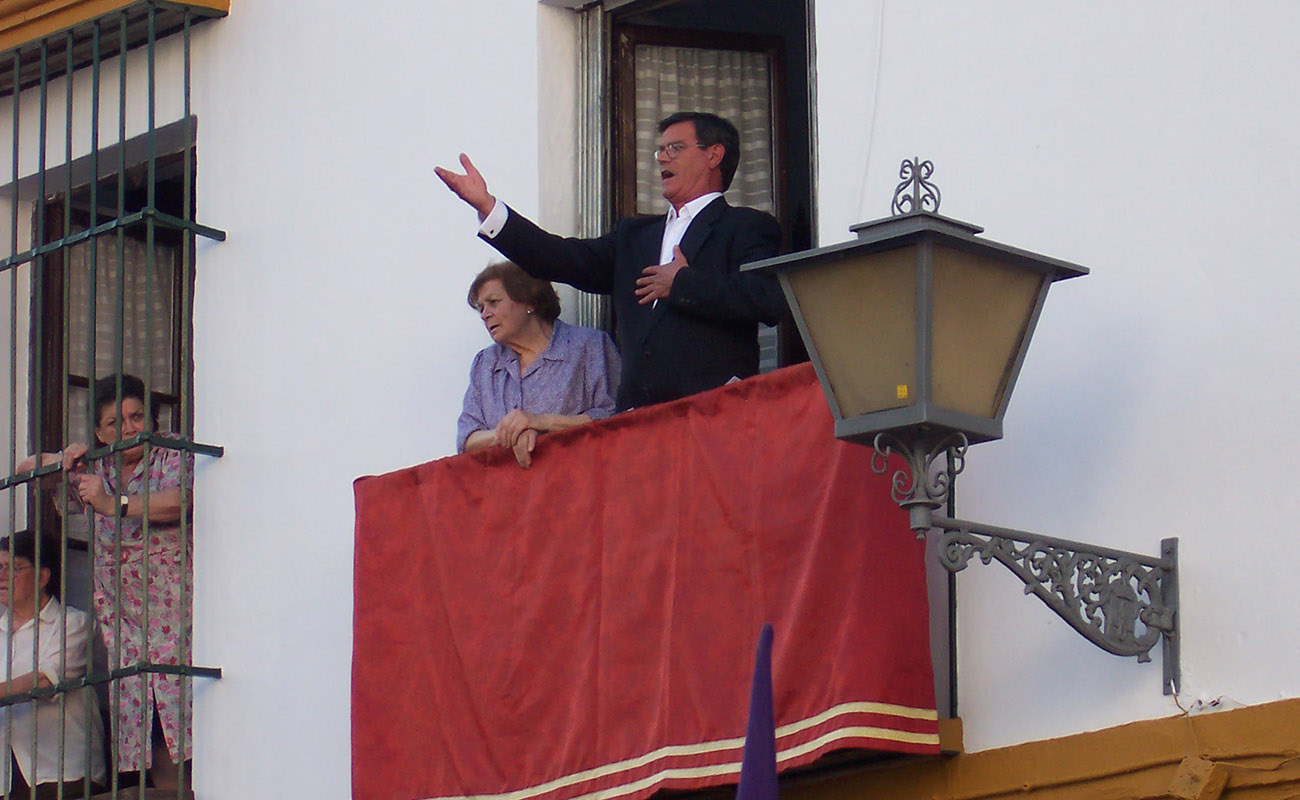Grandpa talks about saetas and saeteros
Manuel and Rafael el Gloria (also from Jerez), revolutionized the saeta and popularized the typical flamenco way of singing them. After them came Pastora Pavón and Isabelita de Jerez, the best female singers of this palo.

-Granpda, I don’t think we’ve ever talked about saetas and saeteros. Don’t you like saetas?
-I love saetas, and I think I was lucky to have lived through their golden age, which I reckon was the early 1900s. Your great-grandfather, that is, my dad, used to talk a lot about those geniuses of the XIX century, and how saetas were sang by Tomás el Nitri, los Marrurros de Jerez, Salvaorillo, Frijones and Silverio.
-In those days saetas weren’t “flamenco” yet, right?
-Of course they were! They were flamencas because the artists who sang them were flamencos themselves. I cannot imagine El Nitri singing the so-called saetas llanas that were sung by the Fransciscan friars from Marchena or Cabra. He would have only sung saetas jondas. The thing is that they never recorded them, so we’ll never know for sure, but I bet they were superb. Look, when Manuel Torres arrived in Seville, at the turn of the century, he brought with him that kind of saeta, which prevailed in Seville soon after. He came to Seville when he was 20, and he would have heard in Jerez and Cádiz many gypsies who sang saetas with a gypsy flavor, such as Paco la Luz or his own uncle, the great cantaor Joaquín Lacherna, the brother of Manuel’s mother, Tomasa.
-Was Manuel Torres the best saetero of them all?
-Without a doubt, Manolito. At the time, the folkloric saetas from the convents was what people sang in Seville. Manuel and Rafael el Gloria (also from Jerez), revolutionized the saeta and popularized the typical flamenco way of singing them. After them came Pastora Pavón and Isabelita de Jerez, the best female singers of this palo. Another great saetera was La Finito de Triana, who actually wasn’t from Triana, nor grew up there, although some people say so.
-What about Centeno and Vallejo?
-Those two cantaores from Seville turned the saeta into a top show, because they were spectacular, particularly Vallejo, although they didn’t have the jondo feel of Manuel and El Gloria. The type of voice doesn’t define the quality of cante. Knowledge does. Yet, different types of voice create different type of emotions, and because of this I prefer El Majareta and El Gloria, of course. Paco Mazaco was another genius of the saeta, too.
-No one ever talks about Pepe Valencia, saetero from Seville. I’ve heard three saetas by him and I think he was amazing.
-Pepito Valencia was what we call a balconist, a specialist. When he sang on Cuna street, which he did every year, all other streets in the city center would be empty. He only specialized in saetas, but on that he was the king, due to his mastery of his self-assured voice.
-How good was Niña de la Alfalfa?
-Rocío Vega Farfán (her real name) was an opera singer, she wasn’t flamenca. Yet, she became the queen of the balconies in old-town Seville. She would sing in La Alfalfa and people could hear her in Triana because, being well versed in opera techniques, she knew how to project her voice. That’s why she was famous.
-We shouldn’t even get started with Tomás, right grandpa?
-We shouldn’t, otherwise we’ll never end. I once heard him sing in San Román, and his saeta is still deep inside me.
-What about the most recent ones? Caracol, Mairena, el Pinto…
-El Pinto was too sweet for my liking, and saetas are all about bitterness and sorrow, but he was a great cantaor and a good saetero. Caracol was a genius, he would lose his mind singing saetas, and the gypsies would rip their shirts off when he sang in San Román. Mairena, who sang in the style of Torres and El Gloria, was also spectacular. Almost by chance, he started singing in the Holy Week of Seville, before the War, and he became renowned for his saetas.
-Do you have any funny stories about saetas in Seville?
-Yes, I have a good one. There was this little guy in Seville, who was sort of a clown of every party, being the butt of many jokes and pranks. One night he insisted singing a saeta to the Virgin of the Macarena (whose image was being brought in a procession on Campana street) from the sidewalk outside Bar Pinto. Due to his short stature, Beni de Cádiz lifted him up on a barrel that was on the sidewalk. As the procession with the image of the Virgin neared, the little guy started singing from the top of the barrel. Beni slowly rotated the barrel and, since the little man used to sing with his eyes closed, he ended up singing his saeta to a shelf in a hat shop which was besides Bar Pinto.
-That was so mean, grandpa.
-Quite a prankster, that Beni.




